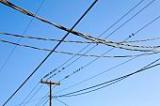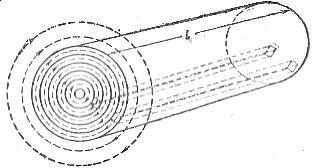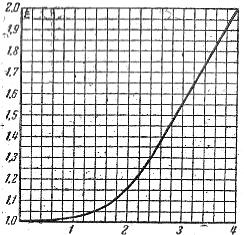Surface effect and proximity effect
 The resistance of the conductor to direct current is determined by the well-known formula ro =ρl / S.
The resistance of the conductor to direct current is determined by the well-known formula ro =ρl / S.
This resistance can also be determined by knowing the magnitude of the constant current IО and power PO:
ro = PO / AzO2
It turns out that in an alternating current circuit, the resistance r of the same conductor is greater than the resistance constantcurrent: r> rО
This resistance r in contrast to the direct current resistance rO and is called active resistance. The increase in wire resistance is explained by the fact that with alternating current, the current density is not the same at different points in the cross section of the wire. I have conductor surfaces, the current density is higher than with direct current, and the center is smaller.
At high frequency, the irregularities appear so sharply that the current density in a significant central purity of the cross section of the conductor is practically zero., the current passes only in the surface layer, which is why this phenomenon is called the surface effect.
Thus, the surface effect leads to a reduction in the cross-section of the conductor through which the current flows (active cross-section), and therefore to an increase in its resistance compared to the direct current resistance.
To explain the cause of the surface effect, imagine a cylindrical conductor (Fig. 1), consisting of a large number of elementary conductors of the same cross-section, in close proximity to each other and arranged in concentric layers.
The resistances of these wires to direct current, found by the formula ρl / S will be the same.
Rice. 1. The magnetic field of a cylindrical conductor.
An alternating electric current creates an alternating magnetic field around each wire (Fig. 1). Obviously, the elementary conductor located closer to the axis is surrounded by a large magnetic flux surface conductor, therefore the former has a higher inductance and inductive reactance than the latter.
At the same voltage at the ends of elementary wires of length l located along the axis and on the surface, the current density in the first is less than in the second.
Difference v the current density along the axis and along the periphery of the conductor increases with an increase in the diameter of the conductor d, the conductivity of the material γ, the magnetic permeability of the material μ and AC frequency.
The ratio of the active resistance of a conductor r to its resistance at. direct current rО is called the coefficient of skin effect and is denoted by the letter ξ (xi), therefore, the coefficient ξ can be determined from the graph in fig. 2, which shows the dependence of ξ on the product d and √γμμое.
Rice. 2. Chart for determining the skin effect coefficient.
When calculating this product, d should be expressed in cm, γ — in 1 / ohm-cm, μo — v gn/ cm and f = in Hz.
An example. It is necessary to determine the coefficient of the skin effect for I am a copper conductor with a diameter of d= 11.3 mm (S = 100 mm2) at a frequency of f = 150 Hz.
Good job.
According to the graph in fig. 2 we find ξ = 1.03
Unequal current density in a conductor also occurs due to the influence of currents in neighboring conductors. This phenomenon is called the proximity effect.
Considering the magnetic field of currents in the same direction in two parallel conductors, it is easy to show that those elementary conductors belonging to different conductors, which are farthest from each other, are connected with the smallest magnetic flux, therefore the current density in them is the highest. If the currents in parallel wires have different directions, then it can be shown that a high current density is observed in those elementary wires belonging to different wires that are closest to each other.


